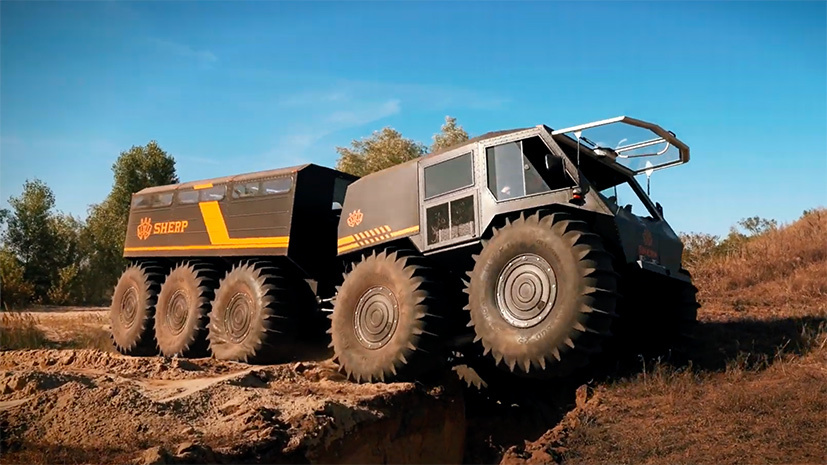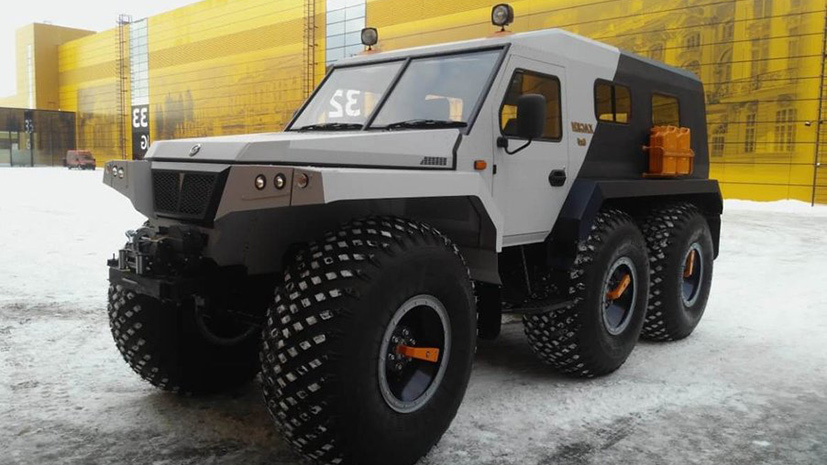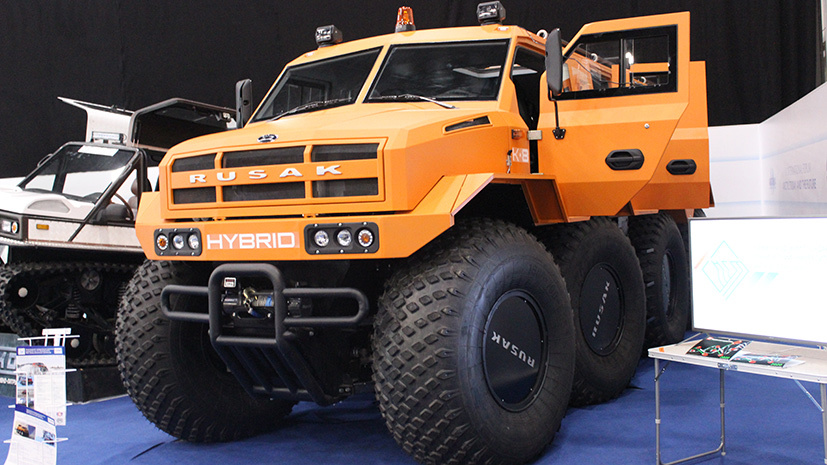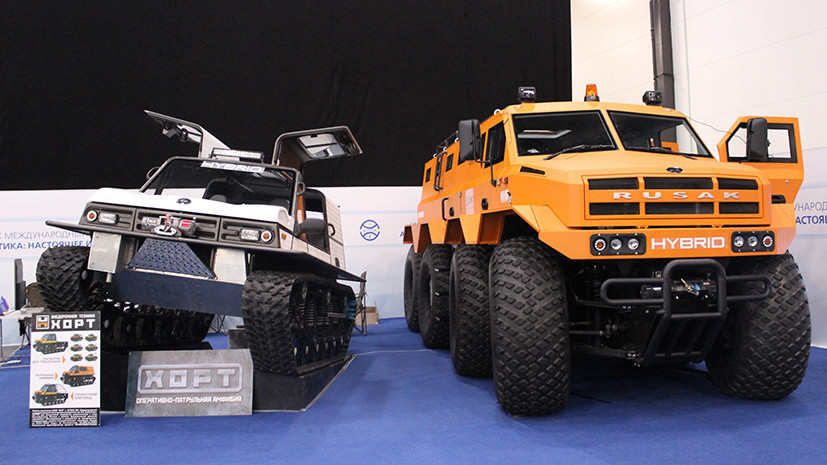In 2020, Russia will start serial production of mass production of the latest Arctic Sherp all-terrain vehicle with a 10-wheel drive, said Alexander Chikin, head of the experimental and testing department of the company Sherp.
The 10×10 all-terrain vehicle by Sherp will be delivered to Russian customers and will also be exported.
“In January, we launch the production of a new Sherp adapted to the conditions of the Arctic. This vehicle was first presented to the public in October 2019 in the city of Toronto. There are already pre-orders for March 2020. We plan to produce the vehicle in several versions: for exploration, cable laying, personnel carrier for workers and various transportation needs,” Chikin said
In addition, a line of multifunctional all-terrain vehicles has been created in Russia, capable of effectively overcoming the most difficult sections of the Arctic terrain and forcing through water obstacles.
The Husky all-terrain vehicle was developed for the needs of the Russian mining companies and law enforcement agencies.
Nizhny Novgorod scientists also introduced the Rusak hybrid wheeled vehicle and the Hort, a particularly lightweight tracked all-terrain vehicle.
According to experts, the new machines will become irreplaceable equipment for Russia in the development of the Arctic.
Sherp is a twin-axle all-terrain vehicle. On its rear six-wheeled platform, you can install a residential or medical module, a transport unit, a power station, a small drilling rig. The vehicle has already passed tests in high latitudes, successfully driving 10 thousand km from Arkhangelsk to Anadyr.
The main advantage of Sherp is its ability to overcome the most difficult areas and effectively cross water obstacles. For example, the vehicle can independently climb out of ice even at full load.
The maximum speed of the amphibious vehicle on the road is 35 km/h, in open water – 6 km/h, the maximum steepness of the rise is 40°, the autonomy is up to 1 thousand hours, load capacity is 5.5 tons, fuel consumption is 9 l/h , the maximum fuel supply is 880 liters with a 300 l capacity of the main fuel tank.
According to the developer the vehicle has pneumatic circulation. The wheels are inflated. You can repair the car without leaving the cab – all of the Sherp’s components and assemblies are located under the floor of the body. But the main feature of the all-terrain vehicle is the steering type control due to the design features of the rear section.
“Sherpa control works in three dimensions. In this regard, instead of the usual steering wheel, we installed a helm, similar to an old aircraft. This “steering wheel” allows the driver to raise, lower and rotate the rear section on difficult sections of the road,” said Chikin.
Another latest development of domestic engineers to move in high latitudes is the Husky all-terrain vehicle with a 6-wheel drive. It was produced by the company TREKOL. According to Andrei Teplov, the chief designer of the enterprise, the Husky is one of the best amphibious vehicles in the world with a duralumin frame-panel body (all-terrain vehicles are predominantly manufactured with a fiberglass body).
“In the Arctic, the duralumin casing has better maintainability. It is relatively easy to repair it in the field, while working with a fiberglass body there’s no way to repair it without a warm room. Also, the Husky’s body has walls twice as thick (50 mm) compared to our other models. This allowed us to warm the car well,” Teplov said.
The all-terrain vehicle is intended for the transportation of goods weighing up to 1.5-2 tons and the carriage of passengers (capacity – 14 people together with the driver). The volume of the main tank of the car is 210 liters, but on the sides of the Husky you can fix additional containers and canisters with fuel. Teplov estimated the total fuel supply of the machine at 340-370 liters.
“Now customers are interested in equipment with a greater carrying capacity and passenger capacity. Our company met these wishes and developed this model. Earlier, we produced a lineup with tires measuring 1030-1050 cm. Accordingly, the carrying capacity was about 1 ton. The Husky had wheels of 1600 cm. Due to this, the bearing capacity was significantly increased,” Teplov emphasized.
The “Husky” passed all of its certification tests at the Bronnitsky training ground of the Russian Ministry of Defense.
In early December, at the “Arctic: Present and Future” forum, held in St. Petersburg, Nizhny Novgorod State Technical University (NSTU) presented its RUSAK-8 arctic vehicle.
Its development is carried out with the financial support of the Russian Ministry of Science and Higher Education. Depending on the modification, the machine is capable of transporting 14-20 people and various loads weighing up to 2.5 tons.
A special feature of Rusak is an electromechanical transmission. The machine is equipped with an internal combustion engine and two electric power units with a capacity of 75 kW each. The hybrid power plant improves the start-up of the car in cold weather and provides an additional resource when driving in conditions of gasoline shortage.
With full tanks (300 l) in the most severe conditions, the vehicle is able to overcome 300 km, on a flat dirt road or highway – up to several thousand kilometers.
At the St. Petersburg Arctic Forum, another vehicle that was presented was the lightweight tracked all-terrain Hort. It weighs up to 2 tons and can carry up to 6 people, as well as up 500 km of load. This type of transport, according to the developers, is indispensable in the conditions of a long cold season.
“Almost all of the components, systems and assemblies of Horta are unified with Rusak-8. This approach optimizes the production process and reduces the cost of machines. Hort performs the same tasks as Rusak. This is the transportation of people and goods, emergency rescue operations, heating. Cars were tested in Yakutia and Chukotka. We can produce up to 50 units of this equipment per year,” said Alexander Blokhin, Head of the Research Laboratory for Special Machines and Mechanisms at the NSTU.
All of these developments are needed due to a shortage of such multifunctional machines in Russia. The necessity to tackle the Arctic is edging closer and safe and secure vehicles are needed.
MORE ON THE TOPIC:
- Russia Launches Combat Icebreaker Ivan Papanin Designed For Security Operations In Arctic (Photos, Video)
- Russia Expanding Its Impressive Icebreaker Fleet Even Further
- Russia Launches Combat Icebreaker Ivan Papanin Designed For Security Operations In Arctic (Photos, Video)
- Norway Digs for Reasons to Oppose Northern Sea Route









